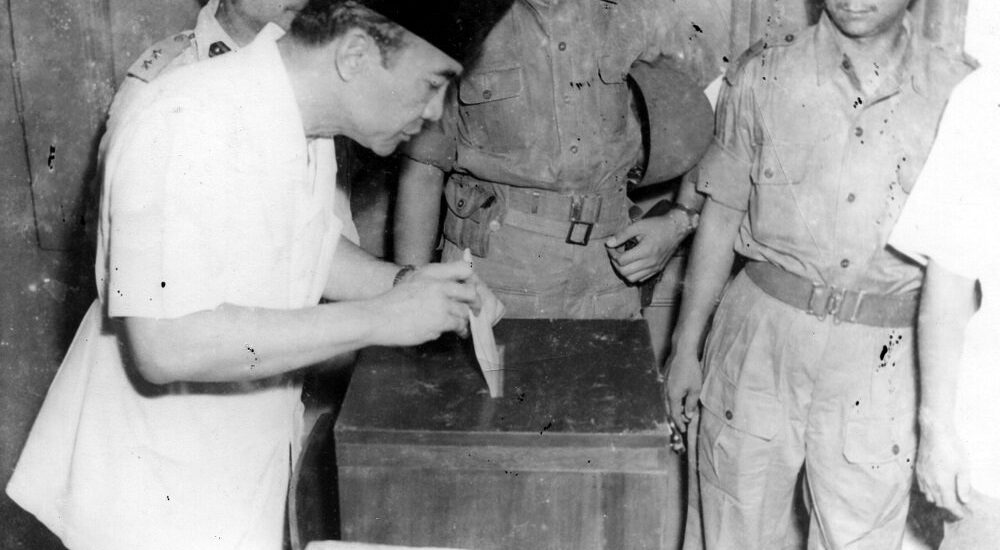In 1955, Indonesia held its first elections using a proportional representation system. This historic moment marked a significant step in the country’s journey towards democracy, allowing diverse voices to be heard in the political arena. The elections not only showcased the aspirations of the Indonesian people but also laid the groundwork for future governance. Join us as we delve into the details of this pivotal event, exploring its impact on the nation and its democratic evolution.
Understanding Pemilu Pertama Kali di Indonesia pada Tahun 1955 Menggunakan Sistem
The first general election, known as “pemilu,” in Indonesia took place in 1955 and marked a significant milestone in the country’s political history. It was an event that not only shaped the future of Indonesian governance but also reflected the hopes and aspirations of its people after gaining independence. This article delves into the details of the 1955 elections, exploring the electoral system used, the political context, and the outcomes.
Background of Indonesia’s First General Election
After declaring independence in 1945, Indonesia faced numerous challenges in establishing a stable government and a democratic system. The struggle for sovereignty involved overcoming colonial legacies, internal conflicts, and societal divisions. By 1955, the country was ready to take a significant step towards democracy through its first general election.
Political Context Leading to the 1955 Elections
The political landscape of Indonesia in the early 1950s was turbulent. Key political parties emerged, reflecting diverse ideologies ranging from nationalism to communism. The political parties that played significant roles included:
- Partai Nasional Indonesia (PNI): A major nationalist party led by Sukarno, Indonesia’s first president.
- Partai Masyumi: An Islamic political party that aimed to integrate Islamic principles into the governance.
- Partai Komunis Indonesia (PKI): Representing the communist ideology, it gained popularity among the working class.
- Partai Syarikat Islam: Advocated for Islamic values and the interests of the Muslim community.
These diverse political entities showcased the country’s rich cultural and ideological multiplicity.
Preparation for The Elections
Planning for the elections was extensive, involving several key steps:
- Formation of the Election Commission: The government established a commission responsible for overseeing the electoral process.
- Voter Registration: Authorities conducted campaigns to ensure a wide and fair registration of voters.
- Public Education: Citizens received information about the electoral process to encourage participation.
The elections were scheduled to occur on September 29 and December 15, 1955.
The Electoral System Used in 1955
The 1955 elections utilized a proportional representation system, ensuring that various political parties could gain representation based on the number of votes they received. This system was crucial for a diverse nation like Indonesia, allowing for a more inclusive political arena.
Description of the Proportional Representation System
Proportional representation in Indonesia’s 1955 elections worked as follows:
- Multi-member Constituencies: Each electoral district had multiple seats, allowing several candidates from different parties to run.
- Vote Allocation: Votes cast for parties directly translated into seats in the legislature. For instance, a party receiving 30% of the votes would ideally secure about 30% of the seats.
- Party Lists: Voters chose parties rather than individual candidates in the initial round, which determined the party’s representation in parliament.
This system aimed to create a legislature that reflected the electorate’s preferences more accurately.
Election Process and Conduct
The election process unfolded in two main phases:
- Legislative Elections: The first phase focused on electing members of the People’s Consultative Assembly (Majelis Permusyawaratan Rakyat, MPR), which would serve as the national legislature.
- Constituent Assembly Elections: The second phase involved electing members to draft the new constitution, addressing Indonesia’s legal structure.
The elections were organized to ensure fairness, with both local and international observers present to monitor the process.
Participation and Voter Turnout
The 1955 elections witnessed a significant voter turnout, indicating the population’s eagerness to participate in shaping their government.
Voter Demographics
The electorate comprised various groups, including:
- Women: For the first time, women gained the right to vote, marking an essential step for gender equality in Indonesia.
- Young Voters: Many first-time voters participated, eager to engage in the democratic process.
- Rural Communities: There was a notable effort to include rural populations, ensuring that their voices were heard.
Voter Turnout Statistics
The voter turnout statistics reflect the enthusiasm and commitment of the Indonesian people:
- Overall Turnout: Approximately 90% of registered voters cast their ballots.
- Urban vs. Rural: Urban areas showcased slightly higher participation rates compared to rural regions, although rural involvement was significant.
This high turnout reflected a collective desire for representation and change.
Results of the 1955 Elections
The outcomes of the 1955 elections were pivotal for Indonesia’s democratic journey. The preliminary results showcased the varying degrees of support for different political parties.
Key Results
The elections concluded with the following outcomes:
- Partai Nasional Indonesia (PNI): Emerged as the leading party, securing a substantial number of seats in the assembly.
- Partai Masyumi: Followed closely, reflecting the strong support for Islamic representation.
- Partai Komunis Indonesia (PKI): Notably increased its presence, highlighting the growing appeal of communist ideology.
Impact of the Election Results
The outcomes had several implications:
- Coalition Government: Due to no single party achieving an outright majority, a coalition government was necessary, fostering political negotiations.
- Political Stability: The election results helped establish a sense of political legitimacy and stability after years of turmoil.
Challenges and Controversies
While the 1955 elections were a progressive step, they were not without challenges and controversies.
Allegations of Fraud
Despite the overall success of the electoral process, allegations of electoral fraud surfaced:
- Vote Rigging: Some political parties claimed that irregularities occurred, which tainted the election’s legitimacy.
- Disparities in Resources: Wealthier parties had better campaigning resources, leading to questions about fairness.
Post-Election Tensions
The aftermath of the elections also brought challenges:
- Factionalism: Differences in ideology among the successful parties led to tensions, complicating coalition-building.
- Continued Struggles: Political instability persisted, with various groups demanding greater representation and influence.
Legacy of the 1955 Elections
The 1955 elections laid the groundwork for Indonesia’s political system, influencing future elections and governance.
Catalyst for Democracy
The elections served as a catalyst for democratic processes in Indonesia:
- Public Participation: They encouraged ongoing public involvement in politics, leading to greater demands for transparency and accountability.
- Institutional Development: The results prompted the development of political institutions that became central to Indonesia’s governance.
Influence on Future Elections
The establishment of a proportional representation system in 1955 set a precedent for subsequent elections:
- Model for Future Elections: The experience gained from these elections influenced the development of the electoral laws and regulations in later years.
- Adapting to Challenges: Future elections learned from the challenges encountered in 1955, enhancing the electoral process.
The legacy of the 1955 elections continues to resonate in Indonesia, reflecting the importance of electoral participation and democratic principles.
In conclusion, the first general election in Indonesia in 1955 was a pivotal moment in the nation’s history. Through its unique electoral system, high voter turnout, and the diverse political landscape, it not only marked the beginning of a democratic era but also set the stage for future electoral practices. The lessons learned from this election continue to shape the political discourse in Indonesia today.
Bagaimana Sejarah Pemilu Indonesia dari Masa ke Masa?
Frequently Asked Questions
What was the significance of the 1955 elections in Indonesia?
The 1955 elections in Indonesia marked a crucial moment in the country’s political history as it was the first time the nation held a democratic election after gaining independence in 1945. These elections were vital for establishing a parliamentary system and for allowing various political parties to compete for power, reflecting the diverse interests and aspirations of the Indonesian people. The successful conduct of these elections helped to legitimize the government and laid the groundwork for future democratic processes in the country.
How did the electoral system work in the 1955 elections?
The 1955 elections used a proportional representation system, allowing multiple political parties to be represented in the parliament based on the percentage of votes they received. This system aimed to ensure that a variety of political voices were heard and that different segments of the population could participate in the governance of the country. Voters selected representatives for both the National People’s Consultative Assembly and regional representatives, contributing to a more inclusive political framework.
What were the main political parties involved in the 1955 elections?
Several political parties participated in the 1955 elections, reflecting the diverse political landscape of Indonesia. The major parties included the Indonesian National Party (PNI), the Nahdlatul Ulama (NU), the Indonesian Christian Party (Parkindo), and the Socialist Party of Indonesia (PSI), among others. Each party represented different ideologies and interests, allowing voters to choose candidates that aligned with their beliefs and aspirations.
What were the outcomes of the 1955 elections?
The 1955 elections resulted in a significant victory for the Indonesian National Party (PNI), which emerged as the dominant party. The National Consultative Assembly was formed, and Sukarno, the first President of Indonesia, played a key role in shaping the new government. The elections led to a coalition government, although political instability soon followed, highlighting the challenges of governance in a young democracy.
How did the 1955 elections impact Indonesia’s political landscape?
The 1955 elections had a lasting impact on Indonesia’s political landscape by introducing a multiparty system and setting a precedent for future elections. It empowered various political entities and allowed for a broader representation of the populace in governance. However, the subsequent political turmoil and conflicts among parties demonstrated the complexities of maintaining stability in a democratic framework, influencing how future elections were conducted in Indonesia.
Final Thoughts
pemilu pertama kali di indonesia pada tahun 1955 menggunakan sistem yang demokratis dan partisipatif. This pivotal moment marked the beginning of a formal electoral process in the nation, setting the stage for future elections. The 1955 elections reflected Indonesia’s commitment to democracy and self-governance. As citizens cast their votes, they embraced the opportunity to influence their country’s direction.






